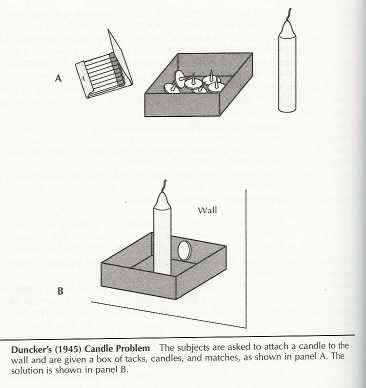
Blog
Motivation: The Important Distinction Between Extrinsic and Intrinsic
By Anonymous | 25 November 2015 |
Do you know what motivates your employees?
The answer is often, “Rewards.”
This past week we watched a TED Talk given by career analyst Dan Pink. He used a very simple experiment to illustrate his main point: rewards-based motivation isn’t sufficient to motivate employees to do better work.
If you’re like us, that assertion gave us pause. But as Pink unpacked his idea, we started to see exactly where he was coming from.
The Candle Problem
Now, back to that simple experiment we mentioned. Pink lead his TED presentation with the candle problem, which is a classic experiment created by Gestalt psychologist Karl Duncker.

In the problem, a person is taken into a room where a table is pushed up against a wall. A box of thumbtacks, a candle and a book of matches sits on the table. The subject is told he or she has to fix the candle to the wall and light it so that the wax doesn’t drip on the table.
Many people go through several solutions before realizing they can empty the thumbtack box, tack it to the wall and then set the candle inside the box.
Did Rewards Help Solve the Candle Problem Quicker? You’d Be Surprised…
Pink pointed out that, a few years ago, economics researches conducted a study in which a group of people were asked to solve the candle problem. However, instead of just letting them do it, they offered each person a reward. Finish (timewise) in the top 20% and you’ll get $5. Solve the problem faster than anyone else and you’ll get $20.
And guess what happened? The people offered the reward actually finished the task an average of 3.5 minutes slower than everyone else!
This, he said, is indicative of a major shift in occupational procedure. Trying to squeeze peak performance out of employees with carrots at the end of a stick just doesn’t work anymore, he said.
And why? Because the motivation is coming from outside the person rather than within them. When employees find internal motivation for doing a particular task, their creativity increases, their problem-solving abilities sharpen and their satisfaction rises. Pretty amazing, isn’t it?
“Our business operating system (how we motivate people) is built around extrinsic motivators. That’s fine for 20th century tasks,” Pink said. “In the 21st century, it doesn’t work like that.”
Internal Motivation Enhances Creativity
Today’s business world is one in which many employees are faced with situations in which there isn’t a single solution, and the path to finding the right answer winds and weaves its way along.
Rewards tend to make employees lock into one set of solutions or one path to answers. But that’s not what today’s workforce needs, Pink postulated.

The key to creating an effective workforce is to focus operational systems on autonomy, mastery and purpose. Give people the space they need to master their craft and they’ll have a sense of purpose they wouldn’t have under the incentive-based system we’re used to.
ROWE
On the leading edge of this movement of non-rewards is ROWE, which stands for “Results-Only Work Environment.”
In a ROWE system, employees don’t have a set schedule. They work where they want to, when they want to and how they want to. Management is only concerned with results.
Using a couple of real-world examples, Pink pointed out that this type of operational system increased productivity and worker satisfaction while decreasing turnover.

ROWE acknowledges the fact that, Pink said, there is a gap between what science says and how businesses work.
“If we repair this mismatch between what science knows and what business does…if we get past this lazy, dangerous ideology of carrots and sticks, we can strengthen our businesses, we can solve a lot of those candle problems,” Pink said, “and maybe, just maybe, we can change the world.”
Utopian or Necessary?
We think Pink brings up some really interesting points. We also believe that the 21st-century workforce is a lot different than it was in the 20th century. Giving employees space to pursue projects on their own schedule can really help with their sense of purpose.
But for the present time, we wonder how effective this strategy would be in blue-collar workforces where work cannot be done remotely or on an employee-directed schedule.
What are your thoughts? Do you think Pink’s ideas are utopian or necessary or just plain irrelevant? Let us know in the comments section below.
In the meantime, you can view Pink’s presentation by clicking here to go to his TED Talk presentation page.
Recent Posts
-
Working From Home — Ultimate Security Tips for a Safe Home Office
-
Unexpected Ways Stress Affects Your Body
-
The Worst Mistakes to Make When Working from Home
-
The Undeniable Worst Mistakes to Make in a Meeting
-
The Top 6 Myths About Leadership Debunked
-
The Best Apps for Busy Professionals
-
Is Telecommuting the Answer to Work-Life Balance?
-
The Importance of Career Goals to Boost Success at Work
-
The Shocking Dangers of Workplace Burnout
-
How to Restart Your Positive Emotions
























